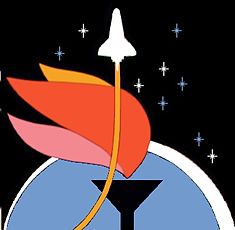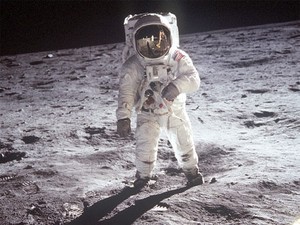It was only 70 years ago that the first rocket reached 100km above the earth’s surface (the boundary of space). Since then all manner of plants, animals and people been launched into space; the most powerful nations on earth have competed for space dominance; man has walked on the moon; we have landed rockets on Mars; ‘tourists’ have started to pay for space travel; over 10,000 satellites are orbiting the planet at any one time; and 18 people have died in the pursuit of science and the unknown. Here we take you on a short tour of the issues around space exploration that may be of particular interest to schools and teachers. First, a couple of useful 'space exploration history' links:
- A brief history of space exploration for kids
- Use Google Moon to see where the Apollo missions landed
The British astronaut Tim Peake has made understanding what it's like in space more accessible for young people though his videos and interviews. Watching a couple of these can provide an entertaining and engaging way to start learning about space. BBC Bitesize has also made a collection of Peak's most informative videos. This year (2018) is NASA's 60th birthday. Here are 60 photos celebrating its history. Star City is the commonly used name for the area outside of Moscow where Russian cosmonauts lived and trained and where many of the firsts of space travel happened. Read about its changing fortunes and check out some great photos. The clip below tells the sad story of Laika, the first dog in space. See also the Wikipedia page about Laika. [embed]https://youtu.be/ocWSY8ac6qE[/embed] The writer and artist Nick Abadzis put together an excellent graphic novel inspired by Laika's tragic life. You have almost certainly heard of Buzz Aldrin and Neil Armstong, but have you come across some of the women who have journeyed to space?
Which countries have space programmes? More than you might think!
Although the North American Space Agency (NASA) may be the most famous space programme in the world, it is by no means the only one. Follow these links to discover more about various space programmes around the world:
- European Space Agency - Space for Kids
- Indian Space Research Organisation
- The Economist - article on China's space programme
- Japan Aerospace Exploration Agency (JAXA)
- BBC News - Africa's journey to space begins on the ground
Teachers in space
[caption id="" align="alignright" width="150"] Teacher in Space logo[/caption] For a brief period of time in the 1980s NASA ran a ‘Teacher in Space’ programme to inspire students and encourage interest in Maths and Science: http://en.wikipedia.org/wiki/Teacher_in_Space_Project. Shown to the right is the programme’s amazing logo. From thousands of applicants, two teachers were chosen. Christa McAuliffe was to be the first teacher in space, but died together with the rest of the crew in the Space Shuttle Challenger disaster in 1986. Her colleague Barbara Morgan continued training as an astronaut and joined the crew of the Space Shuttle Endeavour on its trip to the International Space Station in August 2007. If you were to travel into space, what would your students want you to find out for them? If you are inspired to take your students to the "final front ear", the National STEM Centre have produced a series of activities and resources for schools on the theme of human space exploration. Or you could copy the example of this primary school and launch a teddy bear into space. Or this dad with his son’s toy train: [embed]https://youtu.be/XoMN-zg7r3M[/embed] What messages, images and sounds would you send into space to be found by any life that might exist out there? Why not ask your students what they think signifies and sums up life on earth. Anything like Voyager's Golden Record?
Teacher in Space logo[/caption] For a brief period of time in the 1980s NASA ran a ‘Teacher in Space’ programme to inspire students and encourage interest in Maths and Science: http://en.wikipedia.org/wiki/Teacher_in_Space_Project. Shown to the right is the programme’s amazing logo. From thousands of applicants, two teachers were chosen. Christa McAuliffe was to be the first teacher in space, but died together with the rest of the crew in the Space Shuttle Challenger disaster in 1986. Her colleague Barbara Morgan continued training as an astronaut and joined the crew of the Space Shuttle Endeavour on its trip to the International Space Station in August 2007. If you were to travel into space, what would your students want you to find out for them? If you are inspired to take your students to the "final front ear", the National STEM Centre have produced a series of activities and resources for schools on the theme of human space exploration. Or you could copy the example of this primary school and launch a teddy bear into space. Or this dad with his son’s toy train: [embed]https://youtu.be/XoMN-zg7r3M[/embed] What messages, images and sounds would you send into space to be found by any life that might exist out there? Why not ask your students what they think signifies and sums up life on earth. Anything like Voyager's Golden Record?
Space waste
300,000 objects orbiting the earth, collisions between defunct satellites... space waste is becoming a problem: for more information, see the UN page on space debris and this National Geographic - Space Junk article. What steps would your students take to deal with this global challenge? If your students want to find out what all these satellites are used for, you could use this KS3 lesson from the Met Office: Artificial Satellites
Space tourism, space spending
Would you pay $200,000+ to fly into the unknown? Since 2001, when Dennis Tito became the world’s first space tourist, many people have. You can take private space flights with Virgin Galactic, book your trip here: www.virgingalactic.com. The cost of these small journeys might spark the question, should we be spending any money at all on space exploration while poverty exists in many parts of the world? Why not have a debate with your students? You could also discuss whether it is right that countries which receive foreign aid are spending money on space programmes. Here are a few useful links:
- idebate.org - search on "NASA" or "space" to find some examples of debates
- Why explore space? A 1970 letter to a nun in Africa
- India plans mission to Mars next year - Telegraph
- The Economist: How can poor countries afford space programmes?
Space pictures
[caption id="" align="alignright" width="280"] Spacewalk photo from Luke Bryant - click to view on flickr.com[/caption] And if all of that isn’t enough to inspire you, what about a photo of the universe? As taken by the Hubble space telescope over more than 500 hours. Or check out ten iconic images of the Earth from space. Or take a look at the stamps issued by the Royal Mail to mark the 50th anniversary of Britain's first contribution to space exploration. Or you could simply make a daily visit to NASA’s long-standing website (since 1995!), Astronomy Picture of the Day, to let a little space into your life. Finally, you could take 20 minutes to watch this short film exploring the Overview Effect - a perspective-altering feeling of awe and interconnectedness experienced by those few people who have had the chance to view Earth 'from the outside'. [embed]https://vimeo.com/55073825[/embed] The photo at the top of page is by NASA: In one of the most famous photographs of the 20th Century, Apollo 11 astronaut Buzz Aldrin walks on the surface of the moon near the leg of the lunar module Eagle
Spacewalk photo from Luke Bryant - click to view on flickr.com[/caption] And if all of that isn’t enough to inspire you, what about a photo of the universe? As taken by the Hubble space telescope over more than 500 hours. Or check out ten iconic images of the Earth from space. Or take a look at the stamps issued by the Royal Mail to mark the 50th anniversary of Britain's first contribution to space exploration. Or you could simply make a daily visit to NASA’s long-standing website (since 1995!), Astronomy Picture of the Day, to let a little space into your life. Finally, you could take 20 minutes to watch this short film exploring the Overview Effect - a perspective-altering feeling of awe and interconnectedness experienced by those few people who have had the chance to view Earth 'from the outside'. [embed]https://vimeo.com/55073825[/embed] The photo at the top of page is by NASA: In one of the most famous photographs of the 20th Century, Apollo 11 astronaut Buzz Aldrin walks on the surface of the moon near the leg of the lunar module Eagle

